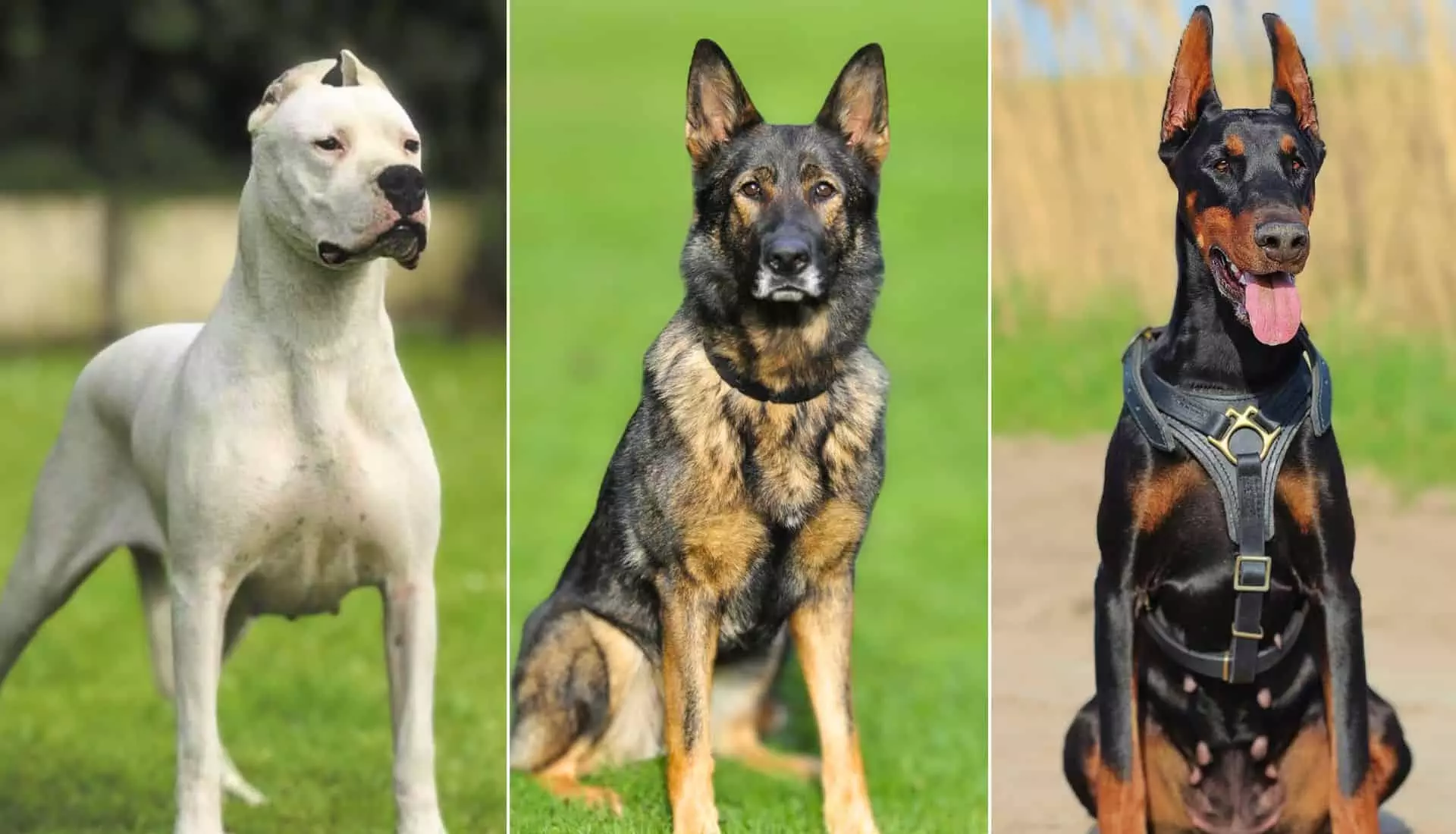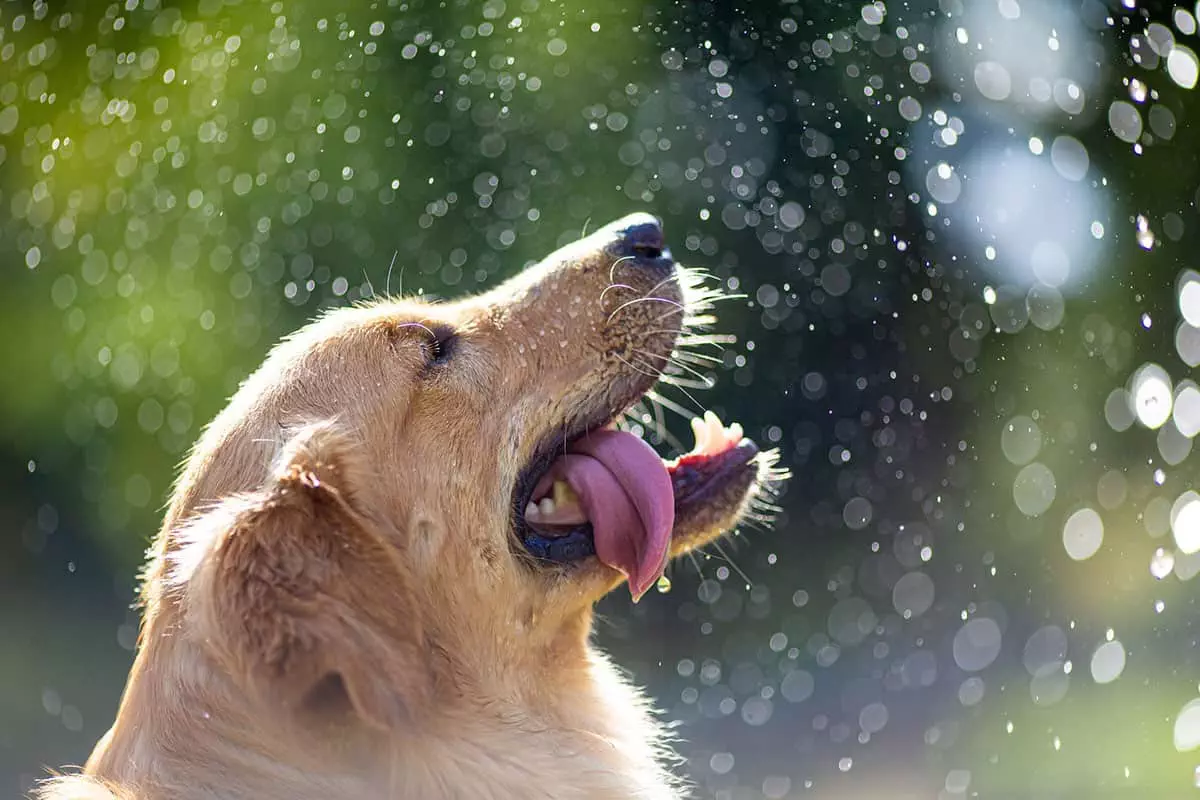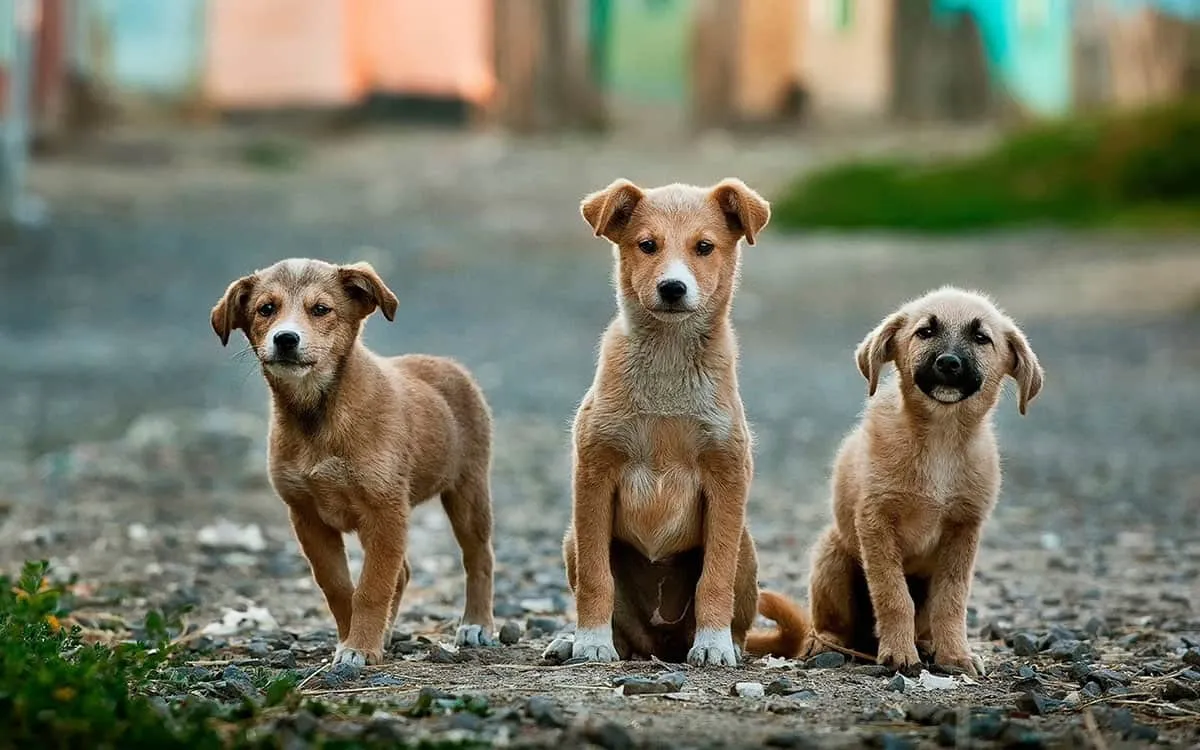Top guarding dog breeds, known for their loyalty, intelligence, and protective instincts, include German Shepherds, Doberman Pinschers, Rottweilers, Bullmastiffs, and Belgian Malinois.
Bark and Protect: The Top Guarding Dog Breeds for Ultimate Security
Guarding dog breeds have been a part of human history for centuries, serving as protectors and companions to their owners. These dogs are known for their loyalty, intelligence, and natural instincts to protect their territory and loved ones.
From ancient times to the present day, guarding dog breeds have played a crucial role in safeguarding homes, livestock, and even military installations. Their presence alone is often enough to deter potential intruders, making them an invaluable asset to any household or property.
In this article, we will explore the characteristics of a good guarding dog, the top guarding dog breeds, training and socialization for guarding dogs, the responsibilities of owning a guarding dog, and how to choose the right guarding dog breed for you.

Characteristics of a Good Guarding Dog
A good guarding dog possesses a combination of traits that make them well-suited for their protective role.
They are typically strong, confident, and fearless, with a natural instinct to defend their territory and family. These dogs are also highly intelligent and trainable, making them capable of learning and following commands with ease.
Additionally, a good guarding dog is loyal and devoted to their owners, forming strong bonds with their human family members.
They are also alert and watchful, always on the lookout for potential threats or intruders.
Finally, a good guarding dog is calm and composed, able to assess situations and respond appropriately without unnecessary aggression. These characteristics make them effective protectors while also being well-behaved and manageable in a domestic setting.
Top Guarding Dog Breeds
There are several dog breeds that are renowned for their guarding abilities, each with its own unique traits and characteristics.
One of the most popular guarding dog breeds is the German Shepherd, known for its intelligence, loyalty, and versatility. This breed is often used in police and military work due to its exceptional trainability and protective instincts.
Another top guarding dog breed is the Rottweiler, a powerful and confident breed that is fiercely loyal to its family. Rottweilers are known for their strength and courage, making them excellent guardians of their home and loved ones.
The Doberman Pinscher is also a top guarding dog breed, valued for its alertness, speed, and fearlessness. This breed is highly trainable and makes a formidable protector when properly trained and socialized.
Other notable guarding dog breeds include the Bullmastiff, Boxer, and Belgian Malinois, all of which possess the traits necessary to excel in a protective role.
German Shepherd
The German Shepherd, also known as the Alsatian, is a versatile and highly intelligent working dog breed. Originating in Germany in the late 19th century, they were initially bred for herding sheep but quickly gained recognition for their loyalty, trainability, and protective instincts.
Key characteristics:
- Intelligence: One of the smartest dog breeds, German Shepherds are quick learners and excel in various roles like police work, search and rescue, and service dog tasks.
- Loyalty: They are fiercely loyal to their families and form strong bonds with their owners.
- Protective instincts: Their natural protectiveness makes them excellent guard dogs, but proper training and socialization are crucial to ensure balanced behavior.
- Athleticism: German Shepherds are strong, agile, and energetic dogs that require regular exercise and mental stimulation.
- Trainability: Due to their intelligence and eagerness to please, they are highly trainable and thrive in structured environments.
Appearance:
- Size: Medium to large-sized dogs, with males typically weighing 65-90 pounds and females 50-70 pounds.
- Coat: They have a thick double coat that comes in various colors, including black and tan, sable, and black.
- Ears: Large, erect ears that give them an alert expression.
- Tail: Long and bushy, carried low when relaxed.
Things to consider:
- Exercise needs: German Shepherds require plenty of exercise and mental stimulation to prevent boredom and destructive behaviors.
- Grooming: Their thick coat requires regular brushing to manage shedding.
- Training: Early and consistent training is essential to ensure they grow into well-behaved and obedient companions.
- Health: German Shepherds are prone to certain health issues like hip and elbow dysplasia, so regular vet checkups are important.
Overall, German Shepherds are loyal, intelligent, and versatile dogs that can make wonderful family pets and working companions with proper training, socialization, and care.
Rottweiler
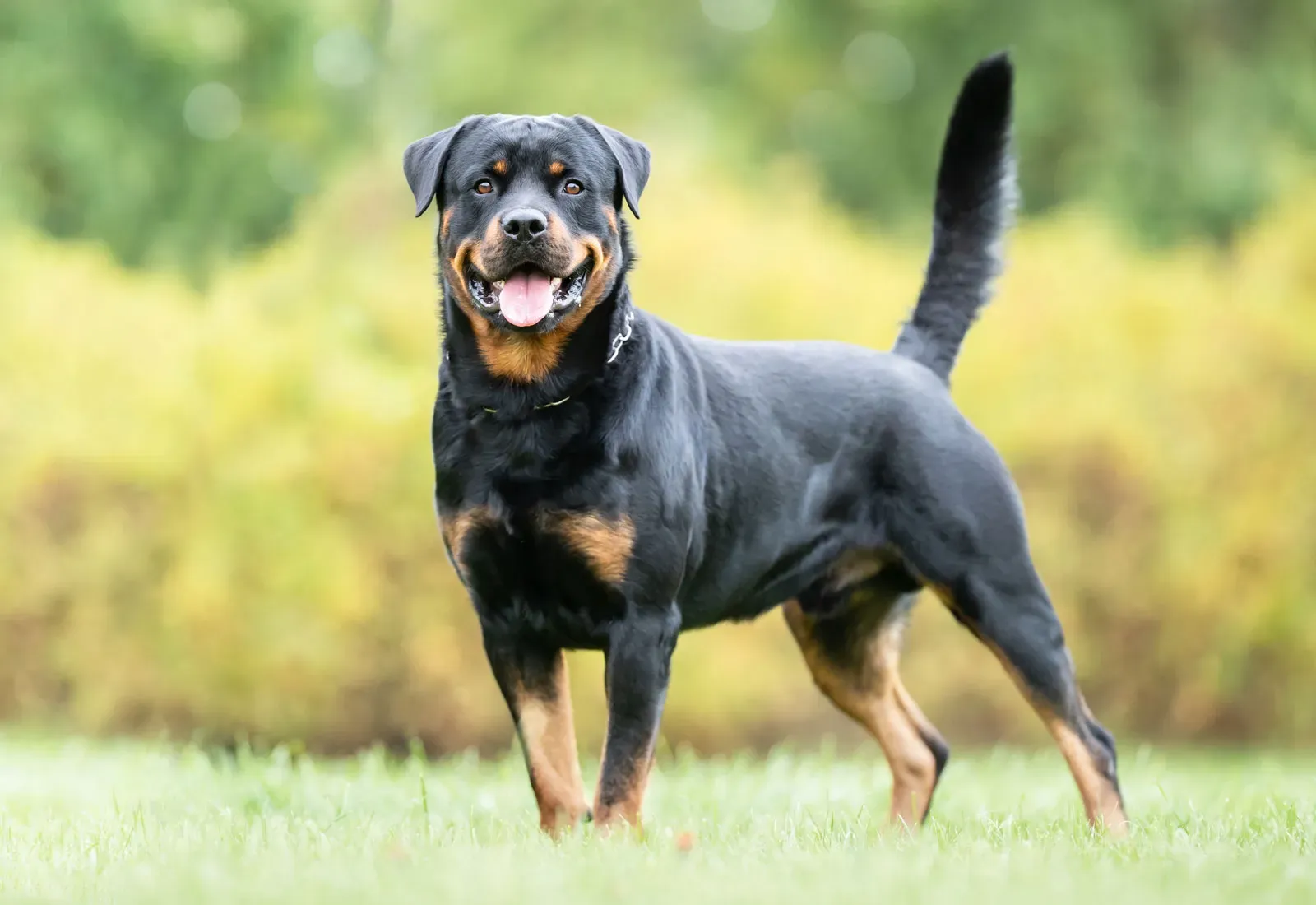
The Rottweiler, often nicknamed “Rottie,” is a powerful and intelligent dog breed with a rich history. Originating in Germany, they were originally bred as herding and guard dogs for butchers, pulling carts laden with meat to market.
Key characteristics:
- Loyalty and protectiveness: Rottweilers are fiercely loyal to their families and make excellent guard dogs due to their protective instincts. Early socialization is crucial to ensure they are well-adjusted and not overly aggressive.
- Intelligence and trainability: They are highly intelligent and eager to please, making them relatively easy to train with consistent and positive reinforcement methods.
- Calm and confident: Rotties are known for their calm demeanor and self-assured nature. They are not easily excitable but can be wary of strangers.
- Strength and athleticism: Rottweilers are strong and muscular dogs, requiring regular exercise to maintain their physical and mental well-being.
- Good-natured with family: While they may be aloof with strangers, Rotties are typically affectionate and playful with their family members, including children.
Appearance:
- Size: Medium to large-sized dogs, with males typically weighing 95-135 pounds and females 80-100 pounds.
- Coat: They have a short, dense, black coat with distinctive rust markings on their face, chest, and legs.
- Head: Broad skull with a well-defined stop and a powerful jaw.
- Ears: Medium-sized, triangular ears that hang down.
- Tail: Traditionally docked short, but natural tails are becoming more common.
Things to consider:
- Training: Early and consistent training is essential to teach Rotties proper manners and control their strong protective instincts.
- Socialization: Expose them to various people, animals, and environments from a young age to prevent them from becoming overly wary or aggressive.
- Exercise: Rottweilers need plenty of exercise to stay healthy and happy. Daily walks, playtime, and mental challenges are important.
- Health: They can be prone to certain health issues like hip and elbow dysplasia, so regular vet checkups and responsible breeding practices are important.
Overall, Rottweilers can make loyal, loving, and protective companions for experienced dog owners who can provide them with the training, socialization, and care they need to thrive.
Doberman Pinscher
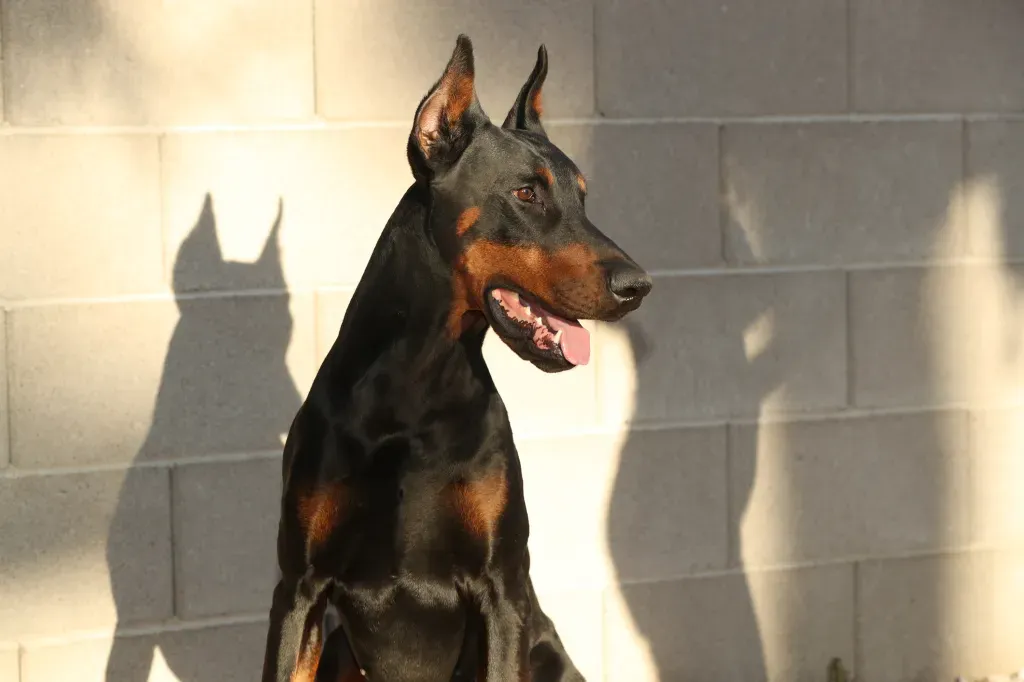
The Doberman Pinscher, often simply called Doberman, is a sleek and powerful dog breed known for its intelligence, loyalty, and protective instincts. Originally bred in Germany in the late 19th century by Karl Friedrich Louis Dobermann, they were designed to be versatile working dogs capable of guarding, police work, and personal protection.
Key Characteristics:
- Intelligence: Dobermans are exceptionally intelligent and eager to please, making them highly trainable and adaptable to various roles.
- Loyalty: They are fiercely loyal to their families and form strong bonds with their owners.
- Alertness and athleticism: Dobermans are naturally alert and athletic dogs, always ready to protect their loved ones and property.
- Courageous and confident: They possess a confident and courageous nature, making them excellent guard dogs and deterrents to potential threats.
- Energetic and playful: Dobermans have a playful side and enjoy engaging in activities with their families, especially when properly exercised and mentally stimulated.
Appearance:
- Size: Medium to large-sized dogs, with males typically standing 26-28 inches tall at the shoulder and females 24-26 inches.
- Coat: Short, smooth, and close-lying, typically black, red, blue, or fawn with rust markings.
- Ears: Traditionally cropped to stand erect, but natural ears are becoming more common.
- Tail: Docked short, but natural tails are becoming more common.
Things to Consider:
- Training: Early and consistent training is essential for Dobermans to manage their energy and develop good manners. Positive reinforcement methods work best.
- Socialization: Proper socialization from a young age is crucial to ensure they are well-adjusted and not overly protective or aggressive towards strangers.
- Exercise: Dobermans are highly energetic dogs that need plenty of physical and mental exercise to prevent boredom and destructive behaviors. Daily walks, playtime, and mental challenges are important.
- Health: They can be prone to certain health issues like dilated cardiomyopathy and von Willebrand’s disease, so regular vet checkups and responsible breeding practices are important.
Overall, Doberman Pinschers can make devoted, intelligent, and protective companions for experienced dog owners who can provide them with the training, socialization, and care they need to thrive. Their loyalty and athleticism make them well-suited for various roles, including family pets, guard dogs, and working dogs.
Training and Socialization for Guarding Dogs
Training and socialization are crucial aspects of owning a guarding dog, as they help to shape the dog’s behavior and ensure that they are well-adjusted and obedient.
Guarding dogs should undergo basic obedience training from an early age to establish boundaries and teach them essential commands such as sit, stay, and come.
Additionally, specialized training for guarding and protection work can be beneficial for certain breeds, as it hones their natural instincts and teaches them how to respond to potential threats.
Socialization is also important for guarding dogs, as it helps them to be comfortable and well-behaved around people and other animals.
Exposing them to various environments, experiences, and individuals from a young age can help to prevent fearfulness or aggression towards unfamiliar situations.
Proper training and socialization are essential for ensuring that a guarding dog is well-behaved, reliable, and safe to have in a domestic setting.
Choosing the Right Guarding Dog Breed for You
When choosing a guarding dog breed, it is important to consider your lifestyle, living situation, and experience with dogs. Some guarding dog breeds require more space, exercise, and mental stimulation than others, so it is essential to choose a breed that aligns with your capabilities and resources.
Additionally, some breeds may be better suited for families with children or other pets, while others may be more reserved or territorial. It is also important to research the specific traits and characteristics of different guarding dog breeds to ensure that you are prepared for the unique needs of each breed.
Here’s a comparison table to help you choose the right guarding dog breed for your specific needs:
| Breed | Size | Temperament | Trainability | Exercise Needs | Best For… | Considerations |
|---|---|---|---|---|---|---|
| German Shepherd | Large | Loyal, intelligent, protective, versatile | High | High | Active families, experienced owners, various tasks | Requires consistent training and socialization |
| Doberman Pinscher | Medium-Large | Alert, intelligent, loyal, energetic | High | High | Active owners, experienced handlers, personal protection | Needs firm guidance and mental stimulation |
| Rottweiler | Large | Calm, confident, loyal, protective | Moderate | Moderate | Experienced owners, families with older children, guarding property | Early socialization is crucial |
| Bullmastiff | Large | Calm, loyal, courageous, good with children | Moderate | Moderate | Families with older children, guarding property | Needs space and consistent training |
| Belgian Malinois | Medium | Intense, energetic, intelligent, strong work drive | High | Very High | Experienced handlers, active lifestyles, working roles | Requires extensive training and mental stimulation |
Consulting with breeders, trainers, or experienced owners can also provide valuable insight into the temperament and requirements of different guarding dog breeds. Ultimately, choosing the right guarding dog breed involves careful consideration of your lifestyle, preferences, and ability to meet the needs of the breed you select.
The Importance of Guarding Dog Breeds
In conclusion, guarding dog breeds play a vital role in protecting homes, properties, and loved ones. Their natural instincts, intelligence, loyalty, and trainability make them valuable assets in safeguarding against potential threats or intruders.
However, owning a guarding dog also comes with significant responsibilities, including proper training, socialization, care, and attention.
By understanding the characteristics of a good guarding dog, the top guarding dog breeds, training and socialization requirements, responsibilities of ownership, and how to choose the right breed for you, individuals can make informed decisions about adding a guarding dog to their family.
Ultimately, the presence of a well-trained and well-behaved guarding dog can provide peace of mind and security while also enriching the lives of their owners with their loyalty and companionship.
Try this quiz and share your results:
Guarding Dog Breeds Quiz
Which guarding dog breed is known for its exceptional trainability and is often used in police and military work?
Which breed is known for its calm demeanor, loyalty, and strength, making it an excellent guard dog?
Which guarding dog breed is known for its intelligence, alertness, and speed, making it a formidable protector?
Originally posted 2024-03-31 04:34:34.

